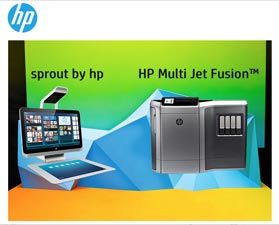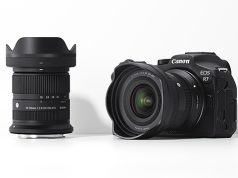
Palo Alto, CA—HP introduced its vision for the future of 3D printing and computing by unveiling its Blended Reality ecosystem. Designed to break down the barriers between the digital and physical worlds, the ecosystem is underpinned by two key advancements.
The first is HP Multi Jet Fusion, a new technology engineered to resolve critical gaps in the combination of speed, quality and cost, and deliver on the potential of 3D printing; the second is Sprout by HP, a first-of-its-kind immersive computing platform designed to redefine the user experience and create a foundation for future immersive technologies.
“We are on the cusp of a transformative era in computing and printing,” said Dion Weisler, executive vice president, Printing & Personal Systems (PPS), HP. “Our ability to deliver Blended Reality technologies will reduce the barriers between the digital and physical worlds, enabling us to express ourselves at the speed of thought—without filters, without limitations. This ecosystem opens up new market categories that can define the future, empowering people to create, interact and inspire like never before.”
Leveraging the company’s decades of expertise in the print market and advanced materials science, HP Multi Jet Fusion is designed to resolve fundamental limitations in today’s 3D print systems while delivering higher productivity and quality at a lower cost.
“As we examined the existing 3D print market, we saw a great deal of potential but also saw major gaps in the combination of speed, quality and cost,” said Stephen Nigro, senior vice president, Inkjet and Graphic Solutions, HP. “HP Multi Jet Fusion is designed to transform manufacturing across industries by delivering on the full potential of 3D printing with better quality, increased productivity and breakthrough economics.”
Multi Jet Fusion is built on HP Thermal Inkjet technology and features a synchronous architecture developed to significantly improve the commercial viability of 3D printing. Specs say it images entire surface areas versus one point at a time to achieve functional build speeds that are at least 10 times faster than the fastest technology in the market today.
According to HP, Multi Jet Fusion features include: a proprietary multi-agent printing process using HP Thermal Inkjet arrays that simultaneously apply multiple liquid agents to produce quality that combines greater accuracy, resiliency and uniform part strength in all three axis directions; it’s capable of delivering fully functional parts with more accuracy, finer details and smooth surfaces, and able to manipulate part and material properties, including form, texture, friction, strength, elasticity, electrical, thermal properties and more; and it integrates various steps of the 3D print process to reduce running time, cost, energy consumption and waste to significantly improve 3D printing economics.
HP is committed to developing a platform that will become an industry standard and remains focused on growing the highest potential commercial markets, added Weisler. While the HP 3D Print technology is available today, HP is working directly with customers under the HP Open Customer Engagement program. Through this program, HP will continue to extend the capabilities of the HP 3D Print platform throughout development and will provide a certification process for partners to drive materials innovation. Wider distribution of the HP 3D Print system will begin in 2016.
By inviting open collaboration, HP hopes to achieve greater flexibility and versatility in 3D Print materials beyond the current use of thermoplastics, which will enable new solutions in segments such as additive manufacturing and will expand applications for consumer goods, engineering and architecture. HP will also bring its color science technology and the full-color capabilities of traditional HP printing to future-generation 3D Print systems.
The first product available in HP’s Blended Reality ecosystem is Sprout by HP, which combines an advanced desktop computer with an immersive, natural user interface to create a new computing experience.
“We live in a 3D world, but today we create in a 2D world on existing devices,” said Ron Coughlin, senior vice president, Consumer PC & Solutions, HP. “Sprout by HP is a big step forward in reimagining the boundaries of how we create and engage with technology to allow users to move seamlessly from thought to expression.”
Combining a scanner, depth sensor, high-resolution camera and projector into a single device, Sprout by HP allows users to take physical items and merge them into a digital workspace. The system delivers a collaboration platform, allowing users in multiple locations to collaborate on and manipulate a single piece of digital content in real-time.
“People have always created with their hands,” added Coughlin. “Concurrently, technology has progressed from the first transistors, through calculators to today’s most sophisticated computing platforms. Until now, the physical and digital worlds have largely been separated and digital creation has remained in 2D. With Sprout by HP, we introduce the first immersive computing platform, seamlessly merging these two worlds together, enabling people to intuitively bring their creations, work, and projects to life in 3D.”
Sprout by HP features a dual-screen experience with a workspace designed for creative expression and human interaction and an integrated, vertical HD touch screen coupled with a 20-point capacitive touch mat. Sprout offers true remote collaboration with an interface that advances how users work and share with simultaneous visual and workspace connectivity, allowing concurrent creativity and content manipulation.
It features a Sprout Illuminator, which is a projection system that scans and captures objects in 3D, allowing users to immediately interact and create. In addition, HP Workspace is a software platform built expressly for Sprout to take advantage of the dual-screen experience to make working and creating “seamless, intuitive and engaging.” Also included is a next-generation computing platform with a fourth generation Intel i7 processor, 1TB of storage in a user-friendly dual-screen interface, and a Windows 8.1 multi-touch experience.
HP also announced the Sprout Marketplace, an application marketplace that contains a growing suite of applications that are optimized to take advantage of an immersive computing platform to enhance how users work, play and engage with entertainment.
The Sprout Marketplace currently contains a suite of Windows-based applications designed for the dual-screen environment, including the Martha Stewart CraftStudio, DreamWorks Animation Story Producer, Crayola’s Draw & Sing, GestureWorks Gameplay and first-party experiences from HP, including Create, Collaborate and Capture, which enables users to capture physical objects, manipulate them in a digital environment and collaborate and share their creations.
New applications, including a range of creative applications for professionals, families, gamers and beyond, will continue to be added to the marketplace regularly. The Sprout Software Development Kit is available at sprout.hp.com/developer.
Sprout by HP is available for preorder at hp.com and will be available for purchase in select retail locations and at hp.com on November 9. hp.com





